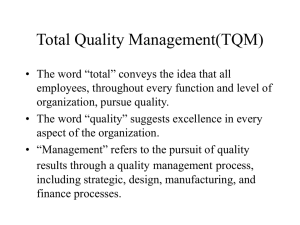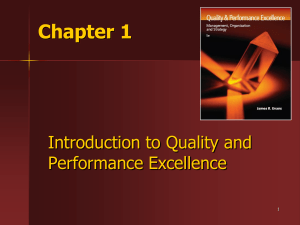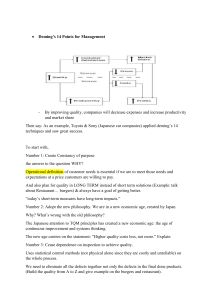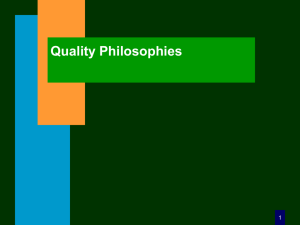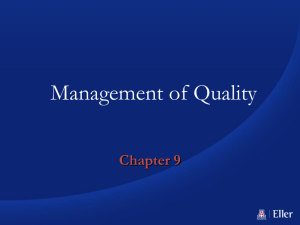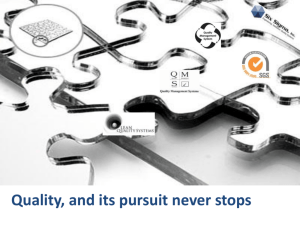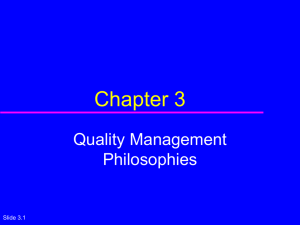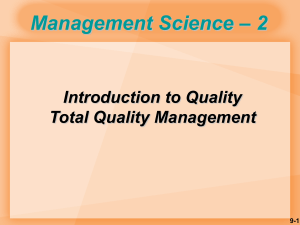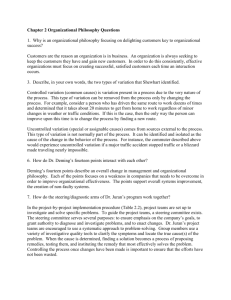QUALITY
advertisement
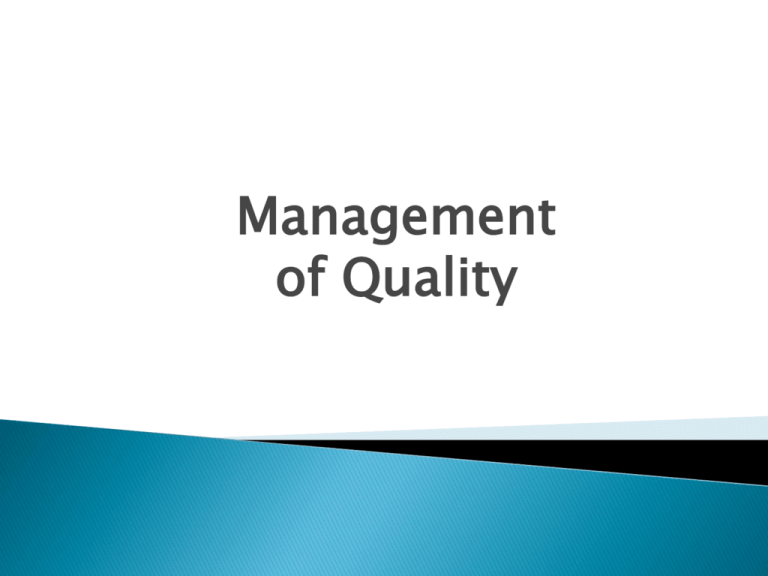
Management of Quality Dictionary has many definitions: “Essential characteristic,” “Superior,” etc. Some definitions that have gained wide acceptance in various organizations: “Quality is customer satisfaction,” “Quality is Fitness for Use.” Quality is the ability of a product or service to consistently meet or exceed customer expectations. 92 Meeting Customer Requirements. (stated or implied) Through Totality of Good and Services. By Conforming to a specified standards. At a given Time or over a period of time. At a price a customer can afforded and has willingness to pay. 93 Before Industrial Revolution, skilled craftsmen served both as manufacturers and inspectors, building quality into their products. Industrial Revolution changed this basic concept to interchangeable parts. Likes of Thomas Jefferson and F. W. Taylor (“scientific management”. 94 • Statistical approaches to quality control started at Western Electric with the separation of inspection division. Pioneers like Walter Shewhart, George Edwards, W. Edwards Deming and Joseph M. Juran were all employees of Western Electric. • After World War II, under General MacArthur's Japan rebuilding plan, Deming and Juran went to Japan. 95 • Deming and Juran introduced statistical quality control theory to Japanese industry. • The difference between approaches to quality in USA and Japan: Deming and Juran were able to convince the top managers the importance of quality. • After 20 years Market started preferring Japanese products and American companies suffered immensely. 96 • America woke up to the quality revolution in early 1980s. Ford Motor Company consulted Dr. Deming to help transform its operations. • (By then, 80-year-old Deming was virtually unknown in USA. Whereas Japanese government had instituted The Deming Prize for Quality in 1950.) • Managers started to realize that “quality of management” is more important than “management of quality.” Birth of the term Total Quality Management (TQM). 97 Walter Shewart ◦ In 1920s, developed control charts ◦ Introduced the term “quality assurance” W. Edwards Deming ◦ Developed courses during World War II to teach statistical quality-control techniques to engineers and executives of companies that were military suppliers ◦ After the war, began teaching statistical quality control to Japanese companies Joseph M. Juran ◦ Followed Deming to Japan in 1954 ◦ Focused on strategic quality planning Armand V. Feigenbaum ◦ In 1951, introduced concepts of total quality control and continuous quality improvement Philip Crosby Kaoru Ishikawa ◦ In 1979, emphasized that costs of poor quality far outweigh the cost of preventing poor quality ◦ In 1984, defined absolutes of quality management— conformance to requirements, prevention, and “zero defects” ◦ Promoted use of quality circles ◦ Developed “fishbone” diagram ◦ Emphasized importance of internal customer 1924 - Statistical process control charts 1930 - Tables for acceptance sampling 1940’s - Statistical sampling techniques 1950’s - Quality assurance/TQC 1960’s - Zero defects 1970’s - Quality assurance in services 912 Characteristic a) Technological – b) Psychological – c) Reliability, Maintainability and Availability Contractual – e) Taste, Status and Beauty Time Oriented – d) Strength, Hardness and Surface Finishing Contractual Provision Ethical – Courtesy and Honesty 913 • Quality of design – Quality of Market Research – Quality of Concept – Quality of specifications • Quality of Conformance – Technology – Manpower – Management • Availability – Reliability – Maintainability – Logistical Support • Example in Quality of Design in Car Industry Size Appearance Comfort Fuel Economy Comfort Material Used Service 914 • Performance: main characteristics of the product/service Conformance : how well product/service conforms to customer’s expectations. Aesthetics: appearance, feel, smell, taste Special Features: extra characteristics Reliability: consistent • Durability: Product life • Perceived Quality: indirect evaluation ( • Serviceability: after sale service • • • • reputation) PROPOSED BY 915 PROF. DAVID GARDIN FROM TO Reactive Proactive Detection & Inspection Prevention Acceptable Quality Level Zero Defect Blame Placing Problem Solving Cost or Quality Cost & Quality Quality Cost More Quality Cost Less Meet the Specification Continuous Improvement 916 FROM TO Quality Department has R&D, Purchasing, Marketing, only quality Problem Operations etc have quality problem Subordinate to Management team Part of Management Team Quality is Technical Quality is Managerial 917 Convenience Reliability Responsiveness Time Assurance Courtesy Tangibles 918 Dimension Examples 1. Convenience Was the service center conveniently located? 2. Reliability Was the problem fixed? 3. Responsiveness Were customer service personnel willing and able to answer questions? 4. Time How long did the customer wait? 5. Assurance Did the customer service personnel seem knowledgeable about the repair? 6. Courtesy Were customer service personnel and the cashierfriendly and courteous? 7. Tangibles Were the facilities clean, personnel neat? 919 Loss of business: Customer quietly stops buying Liability: Due to damages or injuries Productivity: Rework or scrap (more Costs input) 920 Enhance reputation Increase market share Greater customer loyalty Lower liability Cost Fewer complains Lower production cost Higher profits Top management Design Procurement Production/operations Quality assurance Packaging and shipping Marketing and sales Customer service 922 Failure Costs - costs incurred by defective parts/products or faulty services. Internal Failure Costs ◦ Costs incurred to fix problems that are detected before the product/service is delivered to the customer. External Failure Costs ◦ All costs incurred to fix problems that are detected after the product/service is delivered to the customer. 923 Appraisal Costs ◦ Costs of activities designed to ensure quality or uncover defects Prevention Costs ◦ All TQ training, TQ planning, customer assessment, process control, and quality improvement costs to prevent defects from occurring 924 ◦ Upon Received of Raw Materials ◦ Before Costly & irreversible Operations ◦ Before work that could hide defect ◦ Upon Completion of a product ◦ Before stocking high value items ◦ Before shipment to customers 925 END OF PART – 1 926
